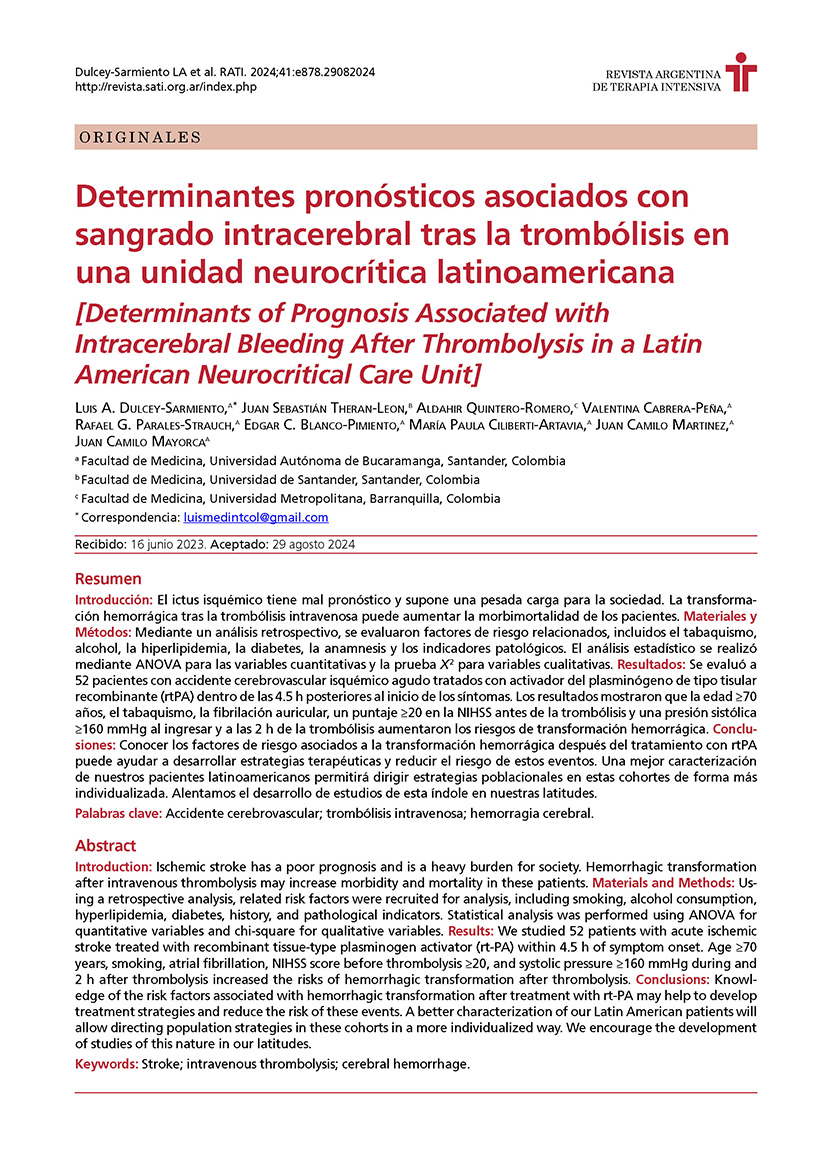Determinantes pronósticos asociados con sangrado intracerebral tras la trombólisis en una unidad neurocrítica latinoamericana
Contenido principal del artículo
Resumen
Introducción: El ictus isquémico tiene mal pronóstico y supone una pesada carga para la sociedad. La transformación hemorrágica tras la trombólisis intravenosa puede aumentar la morbimortalidad de los pacientes. Materiales y Métodos: Mediante un análisis retrospectivo, se evaluaron factores de riesgo relacionados, incluidos el tabaquismo, alcohol, la hiperlipidemia, la diabetes, la anamnesis y los indicadores patológicos. El análisis estadístico se realizó mediante ANOVA para las variables cuantitativas y la prueba X2 para variables cualitativas. Resultados: Se evaluó a 52 pacientes con accidente cerebrovascular isquémico agudo tratados con activador del plasminógeno de tipo tisular recombinante (rtPA) dentro de las 4.5 h posteriores al inicio de los síntomas. Los resultados mostraron que la edad ≥70 años, el tabaquismo, la fibrilación auricular, un puntaje ≥20 en la NIHSS antes de la trombólisis y una presión sistólica ≥160 mmHg al ingresar y a las 2 h de la trombólisis aumentaron los riesgos de transformación hemorrágica. Conclusiones: Conocer los factores de riesgo asociados a la transformación hemorrágica después del tratamiento con rtPA puede ayudar a desarrollar estrategias terapéuticas y reducir el riesgo de estos eventos. Una mejor caracterización de nuestros pacientes latinoamericanos permitirá dirigir estrategias poblacionales en estas cohortes de forma más individualizada. Alentamos el desarrollo de estudios de esta índole en nuestras latitudes.
Detalles del artículo

Esta obra está bajo una licencia internacional Creative Commons Atribución 4.0.
La revista no retiene los derechos de reproducción (copyright) por lo que los autores pueden volver a publicar sus trabajos con la sola mención a la fuente original de publicación.
Citas
Modrego PJ. The risk of symptomatic intracranial hemorrhage after thrombolysis for acute stroke: Current concepts and perspectives. Ann Indian Acad Neurol [Internet]. 2019;22(3):336–40. Disponible en: http://dx.doi.org/10.4103/aian.AIAN_323_18
Charbonnier G, Bonnet L, Biondi A, Moulin T. Intracranial bleeding after reperfusion therapy in acute ischemic stroke. Front Neurol [Internet]. 2020;11:629920. Disponible en: http://dx.doi.org/10.3389/fneur.2020.629920
Tsivgoulis G, Kargiotis O, De Marchis G, Kohrmann M, Sandset EC, Karapanayiotides T, et al. Off-label use of intravenous thrombolysis for acute ischemic stroke: a critical appraisal of randomized and real-world evidence. Ther Adv Neurol Disord [Internet]. 2021;14:1756286421997368. Disponible en: http://dx.doi.org/10.1177/1756286421997368
Berge E, Whiteley W, Audebert H, De Marchis GM, Fonseca AC, Padiglioni C, et al. European Stroke Organisation (ESO) guidelines on intravenous thrombolysis for acute ischaemic stroke. Eur Stroke J [Internet]. 2021;6(1):I–LXII. Disponible en: http://dx.doi.org/10.1177/2396987321989865
Toyoda K, Koga M, Iguchi Y, Itabashi R, Inoue M, Okada Y, et al. Guidelines for intravenous thrombolysis (recombinant tissue-type plasminogen activator), the third edition, march 2019: A guideline from the japan stroke society. Neurol Med Chir (Tokyo) [Internet]. 2019;59(12):449–91. Disponible en: http://dx.doi.org/10.2176/nmc.st.2019-0177
Alamowitch S, Turc G, Palaiodimou L, Bivard A, Cameron A, De Marchis GM, et al. European Stroke Organisation (ESO) expedited recommendation on tenecteplase for acute ischaemic stroke. Eur Stroke J [Internet]. 2023;8(1):8–54. Disponible en: http://dx.doi.org/10.1177/23969873221150022
Han TS, Gulli G, Fry CH, Affley B, Robin J, Fluck D, et al. Adverse consequences of immediate thrombolysis-related complications: a multi-centre registry-based cohort study of acute stroke. J Thromb Thrombolysis [Internet]. 2022;53(1):218–27. Disponible en: http://dx.doi.org/10.1007/s11239-021-02523-2
Botelho A, Rios J, Fidalgo AP, Ferreira E, Nzwalo H. Organizational factors determining access to reperfusion therapies in ischemic stroke-systematic literature review. Int J Environ Res Public Health [Internet]. 2022;19(23). Disponible en: http://dx.doi.org/10.3390/ijerph192316357
Lin S-F, Chen C-F, Hu H-H, Ho B-L, Chen C-H, Chan L, et al. Comparison of different dosages of alteplase in atrial fibrillation-related acute ischemic stroke after intravenous thrombolysis: A nationwide, multicenter, prospective cohort study in Taiwan. J Am Heart Assoc [Internet]. 2022;11(3):e023032. Disponible en: http://dx.doi.org/10.1161/JAHA.121.023032
Bagoly Z, Szegedi I, Kálmándi R, Tóth NK, Csiba L. Markers of coagulation and fibrinolysis predicting the outcome of acute ischemic stroke thrombolysis treatment: A review of the literature. Front Neurol [Internet]. 2019;10:513. Disponible en: http://dx.doi.org/10.3389/fneur.2019.00513
Zhou Y, Yan S, Song X, Gong Y, Li W, Wang M, et al. Intravenous thrombolytic therapy for acute ischemic stroke in Hubei, China: a survey of thrombolysis rate and barriers. BMC Neurol [Internet]. 2019;19(1):202. Disponible en: http://dx.doi.org/10.1186/s12883-019-1418-z
Evans, N. R., Sibson, L., Day, D. J., Agarwal, S., Shekhar, R., & Warburton, E. A. (2022). Hyperacute stroke thrombolysis via telemedicine: a multicentre study of performance, safety and clinical efficacy. BMJ open, 12(1), e057372. https://doi.org/10.1136/bmjopen-2021-057372
Ng SH-X, Wong AWK, Chen CH, Tan CS, Müller-Riemenschneider F, Chan BPL, et al. Stroke factors associated with thrombolysis use in hospitals in Singapore and US: A cross-registry comparative study. Cerebrovasc Dis [Internet]. 2019;47(5–6):291–8. Disponible en: http://dx.doi.org/10.1159/000502278
Herath, H. M. M. T. B., Rodrigo, C., Alahakoon, A. M. B. D., Ambawatte, S. B., Senanayake, S., Senanayake, B., & Fernando, A. (2021). Outcomes of stroke patients undergoing thrombolysis in Sri Lanka; an observational prospective study from a low-middle income country. BMC neurology, 21(1), 434. https://doi.org/10.1186/s12883-021-02475-3
Nordanstig A, Curtze S, Gensicke H, Zinkstok SM, Erdur H, Karlsson C, et al. EndoVAscular treatment and ThRombolysis for Ischemic Stroke Patients (EVA-TRISP) registry: basis and methodology of a pan-European prospective ischaemic stroke revascularisation treatment registry. BMJ Open [Internet]. 2021;11(8):e042211. Disponible en: http://dx.doi.org/10.1136/bmjopen-2020-042211
Koga M, Yamamoto H, Inoue M, Asakura K, Aoki J, Hamasaki T, et al. Thrombolysis with alteplase at 0.6 mg/kg for stroke with unknown time of onset: A randomized controlled trial: A randomized controlled trial. Stroke [Internet]. 2020;51(5):1530–8. Disponible en: http://dx.doi.org/10.1161/STROKEAHA.119.028127
Fu Q, Wang X, Zhang D, Shi L, Wang W, Guo Z, et al. Improving thrombolysis for acute ischemic stroke: The implementation and evaluation of a theory-based resource integration project in China. Int J Integr Care [Internet]. 2022;22(1):9. Disponible en: http://dx.doi.org/10.5334/ijic.5616

